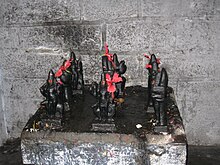Navagraha

The navagraha are nine heavenly bodies and deities that influence human life on Earth according to
Sanskrit: ग्रह "planet, seizing, laying hold of, holding"). The nine parts of the navagraha are the Sun, Moon, planets Mercury, Venus, Mars, Jupiter, and Saturn, and the two nodes of the Moon.[2]

The term planet was applied originally only to the five planets known (i.e., visible to the
Hindu temples
around the world have a designated place dedicated to the worship of the navagraha.
List
| No. | Image | Name | Western equivalent | Day |
|---|---|---|---|---|
| 1. | 
|
Surya | Sun | Sunday |
| 2. | 
|
Chandra | Moon | Monday |
| 3. | 
|
Mangala | Mars | Tuesday |
| 4. | 
|
Budha | Mercury | Wednesday |
| 5. | 
|
Bṛhaspati
|
Jupiter | Thursday |
| 6. | 
|
Shukra | Venus | Friday |
| 7. | 
|
Shani | Saturn | Saturday |
| 8. | 
|
Rahu | Ascending node of the Moon | |
| 9. | 
|
Ketu | Descending node of the Moon |
Music
jyotisha sastras
.
See also
References
- ^ Sanskrit-English Dictionary by Monier-Williams, 1899
- ^ "Dikshitar: Navagraha". www.medieval.org. Retrieved 2020-06-12.
External links
 Media related to Navagraha at Wikimedia Commons
Media related to Navagraha at Wikimedia Commons

